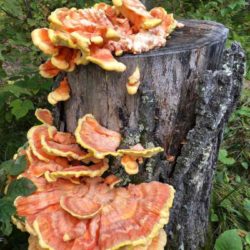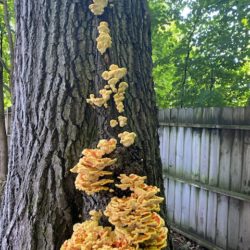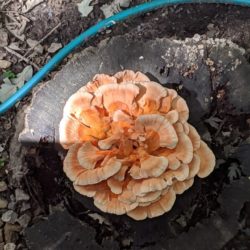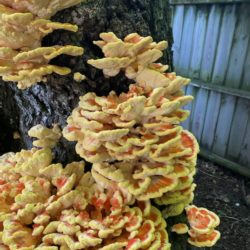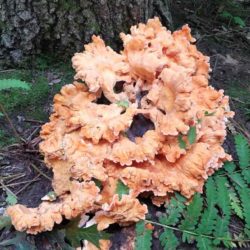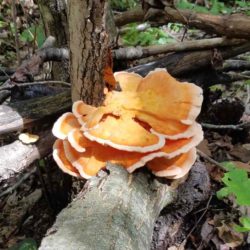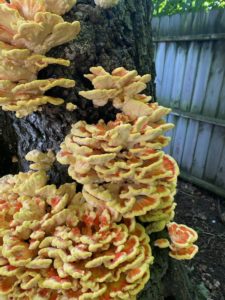
Chicken of the Woods
Laetiporus Sulphureus, L. Cincinnatus
AKA: AKA Sulphur shelf, chickens (different than hens), COTW
Description:
Chicken of the Woods are polypores, meaning they grow off the side of trees, often like shelves. They will often grow in layers or tiers overlapping each other. ALWAYS found on wood, never on ground. Unmistakable bright yellow and/or orange color is a definitive characteristic which eventually fades with age. Yes, white chickens (L. Cincinnatus) also exist but are less common. Often have a different colored “ring” around the edge of the shelf/cap. Flesh is meaty (kind of like chicken right?).
Generally found from spring to autumn. Always love finding a spring chicken!
Coolness Factor:
Great replacement for chicken of course!
Inhibits staph bacteria growth.
Where Found:
Almost exclusively oaks, specifically dead or dying ones (hint hint). The tricky ones are on seemingly live trees, but in reality, that tree is technically on it’s way out. While no where close to as common, they can grow on some conifers on occasion.
Do NOT consume if found on conifers/pine trees! They may contain toxins that lead to gastric distress. Probably won’t kill you, but also won’t make you feel very well!!
Saprotrophic – feeds on decaying organic matter (Hint: look for DEAD and DYING trees)
Tips:
Look for DEAD and DYING oak trees. Look high and low as many dead trees have already fallen. And look on all sides of the tree, do not assume that one side of a dead oak tree is indicative of the other side! Yes, sadly, you may occasionally find them up high on a tree, well out of reach. It is truly frustrating.
Check for bugs! They will often beat you to it!
Cleaning
Biggest downfall for most COTW is getting it before the bugs do!! Even a beautiful fresh one may have a couple bugs on or in it. No biggie. Otherwise just brush off any dirt, debris, bugs, etc. Rinse with minimal water.
Cooking
As the name suggests, chickens can be treated like, well, chicken! Especially the thicker ones. Can brush with butter/oil then hit with spices or herbs and thrown on the grill until thoroughly cooked. They do not taste quite like chicken but are often similar in consistency.
Otherwise, slicing and sautéing is always reliable. Pickling COTW is actually surprisingly delicious!
Preserving
Pickling is a great way to preserve them while also being ready-to-eat! COTW do not dehydrate very well, but can be cooked and then frozen, or sometimes just frozen raw.
Look Alikes:
None really. They are pretty distinctive and great for beginners!

